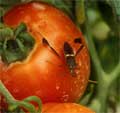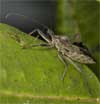Summer Garden Pests
Nothing’s more frustrating than to watch the garden you worked so hard to till, plant and care for be ravaged by insects, mites and diseases. We have to anticipate most diseases and use preventive sprays against them, but not all garden plants have serious disease problems.
Tomatoes might be the exception. Wouldn’t you know our favorite vegetable is also the favorite of a number of pests and diseases, too?
• Early blight may already be your worst enemy. It starts in the spring, when the plants are knee-high to waist-high, and begins with the lower leaves turning yellow. Before you know it, the entire plant has yellow blotches on its leaves, and the lower ones may be entirely brown. At this stage, it’s a bit late to control the disease with fungicides. The key with fungicides is to start early. Apply a labeled product as soon as you see first signs of the problem.
• Powdery mildew fungus can be a problem on squash, but the plants are usually at the end of their productive cycle when the disease becomes noticeable. We’re ready to pull the plants out anyway.
When it comes to bugs, perhaps you’ve heard the organic theory — “I just plant extra and let the bugs have their half.” All too often the bugs sample half of everything! The common-sense approach works best for most gardeners. Be aware of what’s going on in the garden, and deal with it if you have to. If you don’t like to lose to the garden beasties, then you’re probably ready to “arsenal up” with every pesticide on the shelves, but don’t go overboard. A lot of garden crops never have to be sprayed at all. You not only need to keep a close eye on the garden, you need to know the good guys — beneficial insects — from the plant feeders.
• Spider mites rear their ugly, if somewhat tiny, little heads when it turns hot. They build up in such numbers that the foliage begins to take on a white stippled appearance, eventually turning yellow. The plant may even become covered with webs. If you wait this long, it is too late, and you need to pull the plants out and plan for next year. Catch the spider mites early, and you can spray them off with high-pressure water wands or spray with wettable sulfur. Insecticidal soaps and neem oil sprays can also help get them under control.
• Stinkbugs, especially leaf-footed stinkbugs, attack lots of fruits, vegetables and even pecans, but they really like tomatoes. They feed by sucking out the plant juices, leaving a white, corky area under the skin. Usually you can still salvage some of the tomato to eat, but you may have to do a lot of trimming. Pyrethroids are usually recommended for stinkbug control. Hint: if the spray knocks them down, walk around and step on them so they don’t get back up — these bugs are tough.
• Imported fire ants are a nuisance, and they will damage some plants — they love munching on okra pods. They also “farm” aphids — protecting these sucking insects for the honeydew that they excrete. Baits with Spinosad™ are the way to go, since this material is organic and approved for garden use.
• Grasshoppers are another perennial pest. Apply a labeled bait early in the season, or you may need a pellet gun at a later stage!
• Caterpillars are always eating something in the garden — the corn earworm, tomato fruitworm, pickle worms, etc., etc. Fortunately, we have a couple of non-toxic controls — either B.t. (Bacillus thuringiensis) or Spinosad™. (It’s available as a spray material as well as an ant bait.) Spinosad™ is a stomach poison, and the Bt makes the caterpillars sick — really sick.
• Nematodes (root-crippling round worms) are a worry, especially in sandy soils and possibly in raised beds. Other than planting resistant varieties and boosting the organic matter in the soil to encourage beneficial organisms that can reduce nematode populations, there’s not much we can do. A fall crop of cereal rye like Elbon will reduce nematodes, but that’s not going to help your vegetable crop once it’s growing.
Not all insects are bad — some, like the ferocious-looking wheelbug in the photo to the right, are predators and parasites of the garden pests. They need to be encouraged by not spraying when they are active and effecting good pest control. Spray late in the evening after the honeybees have gone home (they don’t attack pests, but they pollinate to ensure fruit formation), and plant a variety of plants to attract the good guys. Just another reason to spend lots of time in the garden studying the critters you find there.
About the author: William D. Adams is the co-author, with Thomas R. LeRoy, of The Southern Kitchen Garden: Vegetables, Fruits, Herbs and Flowers Essential for the Southern Cook. He is a freelance garden writer and avid photographer from Burton and a contributing editor to Neil Sperry’s GARDENS Magazine.
The above photographs of insects and diseases all were taken (and are copyrighted) by William D. Adams. Click on the thumbnail versions shown here to see these garden pests up close!








